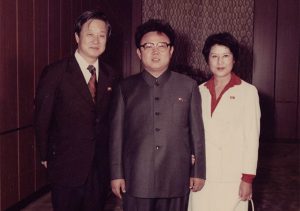Validity of Extratextual Content

By Lee
A film is compelling when we trust the information that we’re given. This is why “it was all a dream” plot twists are a massive let down. Ross Adam and Robert Cannan’s The Lovers and the Despot retells the harrowing story of South Korean director Shin Sang-ok and his wife, actress Choi Eun-hee, and their capture by North Korean dictator Kim Jong-il, in an effort to raise the credentials of North Korean cinema. The style of the documentary consists of found footage, reappropriation, talking heads, tape recordings and reenactments. The tension and dark comedy of the film come from the knowledge that the outrageous story of a man kidnapping two people just to make movies for him actually happened to two people. This tension is artificially manipulated by the directors both through facts and illusion.
The most tense scenes are the ones we know are true. The one time the directors speak from behind the camera is to prompt their intelligence officer to authenticate the tapes of Kim Jong-Il. The IO is wary of discussing what is still considered active intelligence, but relents in a carefully worded endorsement of the tapes. This endorsement is extremely important to the documentary, as much of the tension of the film lays in the validity of the tapes. The tension comes from the actual fact that it is the reclusive North Korean dictator speaking to Choi and Shin, speaking both in adulation and veiled threats. In fact, it is the validity of the tapes that wins Shin his freedom, as he was previously thought to have willingly defected. The contextualization of the tapes, secretly recorded at the risk of Choi and Shin’s lives, makes their use very powerful. We previously learn from Choi and her son that Shin is willingly making films in North Korea, and photographic evidence shows a man doing what he loves. This is strategically undercut with harrowing recordings of Shin and Jong-Il, showing a very one-sided relationship in favor of Il.
The Lovers and the Despot also uses reappropriation from Shin and Choi’s repertoire to ‘reenact’ scenes from their lives. This is where the line between facts and illusions becomes blurred, but in a more interesting and less manipulative way. While Choi talks about meeting her husband, a scene from a South Korean movie of Choi courting another man is shown. Or a man meeting another a man on wharf is a representation of Shin meeting a colleague in Hong Kong. The distilling of their projects down to a few scenes is much like Rose Hobart, Joseph Cornell’s fanvid recut of East of Borneo. There is a hyperfocus on character and actor. Reappropriation retells the story of Choi and Shin and connects characters from disparate films into a new collective universe.
Contextualization and validity are integral to a film. Coffman says “without a compelling context, it seems the most a “found footage” genre film can hope for is to startle its audience by playing loud noises and having stuff jumping into the frame, usually at the same time.”
The article contrasts two faux-snuff films, August Underground and The Poughkeepsie Tapes. The Poughkeepsie Tapes’ “found footage” is more horrifying as the concept is contextualized within the Investigation Discovery style approach of the film; it is presented as a documentary about the discovery of a collection of tape in the home of a serial killer.
Thus, the act of editing the footage together does not compromise the film’s its validity. August Underground began its career with compelling context, i.e. none. It was originally snuff footage distributed randomly under park benches around Philadelphia. You can imagine how disturbing randomly finding such a film would have been. However, once it became a commercial product sold on Amazon, it lost its lack of context. Watching it on DVD, it becomes impossible to suspend your beliefs; you obviously can’t buy and sell real snuff films. In this new context, August Underground becomes merely a boring slog through blood and gore. The power of lack of context and the validity of primary source content is seen in Orson Welles’ War of the Worlds broadcast. All those who tuned in after the context for the story was given were sent into a panic.
Fact becomes illusion when Adam and Cannan begin using reenactments to visualize the events being retold, especially Choi and Shin’s escape. We trust Orson Welles when he says the next hour of F is for Fake is true. We trust Matt Reeves when he says that Cloverfield’s footage was all recovered from the same camera. We trust Adam and Cannan’s intelligence officer that the tapes are genuine. No assurances are made for the reenactments, but still they masquerade as factual. They are made to look like found footage from Betamax; grainy color stock shot hand-held, from the back of a taxi, or of feet running.
Comments are closed, but trackbacks and pingbacks are open.